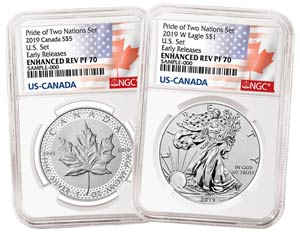The first ever Enhanced Finished-Reverse Proof Silver Eagle was issued as a surprise on July 3rd, 2019 in what was called the Pride of Two Nations Set.
 Bullion.Directory precious metals guest post 18 January, 2020
Bullion.Directory precious metals guest post 18 January, 2020
By Nick Adamo
President at Bullion Shark LLC
This marked not only the first time that the U.S Mint made a Silver Eagle with a Reverse Proof-Enhanced finish, but it also marked the first time the U.S. Mint did a joint coin program with Canada. The set was stunning and featured the first ever, Enhanced Finished-Reverse Proof Silver Eagle, but the first Modified Proof Maple Leaf.
The release of this set was monumental, because it opened the door for the U.S. Mint to work with many other mints around the globe for future coin releases.
Furthermore, the U.S. Mint made the set an instant rarity by only issuing 110,000 sets. 10,000 sets were released by the Canadian Mint and 100,000 were released by the U.S. Mint.
With a total mintage of only 110,000 coins, the Silver Eagle from the Pride of Two Nations Set became one of the lowest mintage Silver Eagles of all time. It is no wonder why this set sold out completely a day of its release. However, it would soon be overshadowed by its sister coin released from San Francisco…
The 2019-S Enhanced-Reverse Proof Silver Eagle, which was released on November 5th, 2019, quickly overshadowed the original West Point minted version of the American Silver Coin from the Pride of Two Nations Set. The main reason for this was because the U.S. Mint decided to limit its mintage to a measly 30,000 coins.
This was extremely significant because it now became the lowest mintage Silver Eagle of all time.
This mintage is even lower than the 1995-W Proof Silver Eagle which held the record prior for over 25 years at 30,125 as the lowest mintage of the coin’s series. To make things even more chaotic, the U.S. Mint decided to limit the household limit to one per customer.
Collectors and investors alike scrambled the day of its release to purchase the coin, as many knew the secondary market would skyrocket because of such a limited mintage. As expected, the coin sold out instantly, the Mint’s website crashed, and the coin started selling for upwards of $1,500 as is from the mint.
Coins in perfect grade 70 were trading for upwards of $3,000. This left many collectors frustrated that they missed out on such an amazing, ground floor opportunity. Collectors who did get lucky, managed to make a quick buck for doing nothing other than purchasing the coin from the mint.
Now with all the commotion around the San Francisco Minted version, the West Point original got left in the dust. However, we think people might be overlooking an amazing opportunity.
 With only 110,000 minted, the West Point minted sister coin is not far off from the 30,000 of the San Francisco version. Furthermore, the coin is still one of the lowest mintage Silver Eagles of all time. That being said, the West Point version is trading for almost 20 times less than the San Francisco version in perfect grade 70! Meanwhile, the S coin is only about three times more rare.
With only 110,000 minted, the West Point minted sister coin is not far off from the 30,000 of the San Francisco version. Furthermore, the coin is still one of the lowest mintage Silver Eagles of all time. That being said, the West Point version is trading for almost 20 times less than the San Francisco version in perfect grade 70! Meanwhile, the S coin is only about three times more rare.
So what is causing such a big price discrepancy?
One, the allure that the San Francisco struck piece is the lowest mintage Silver Eagle ever. Secondly, we must look at supply versus demand. For those who did not get the San Francisco version, it might be an amazing opportunity to buy the West Point not only a fraction of the price.
We think the West Point version poses much value to the collector. We do not have a “crystal ball,” but we could be looking at a very overlooked Modern Rare Coin…
This article was originally published here Bullion.Directory or anyone involved with Bullion.Directory will not accept any liability for loss or damage as a result of reliance on the information including data, quotes, charts and buy/sell signals contained within this website. Please be fully informed regarding the risks and costs associated with trading in precious metals. Bullion.Directory advises you to always consult with a qualified and registered specialist advisor before investing in precious metals.











 Material provided on the Bullion.Directory website is strictly for informational purposes only. The content is developed from sources believed to be providing accurate information. No information on this website is intended as investment, tax or legal advice and must not be relied upon as such. Please consult legal or tax professionals for specific information regarding your individual situation. Precious metals carry risk and investors requiring advice should always consult a properly qualified advisor. Bullion.Directory, it's staff or affiliates do not accept any liability for loss, damages, or loss of profit resulting from readers investment decisions.
Material provided on the Bullion.Directory website is strictly for informational purposes only. The content is developed from sources believed to be providing accurate information. No information on this website is intended as investment, tax or legal advice and must not be relied upon as such. Please consult legal or tax professionals for specific information regarding your individual situation. Precious metals carry risk and investors requiring advice should always consult a properly qualified advisor. Bullion.Directory, it's staff or affiliates do not accept any liability for loss, damages, or loss of profit resulting from readers investment decisions.

Leave a Reply